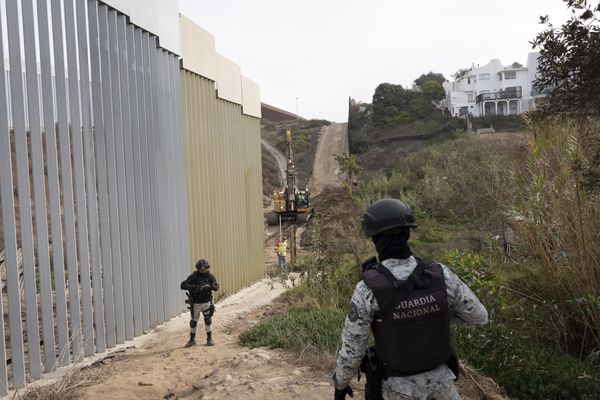By the time they heard the high-pitched thrum of the small, whirring petrol motor overhead, it was already too late.
What happens next when a pilotless, bomb-carrying drone screeches from Russian airspace towards its target is now becoming a familiar daily routine in heart-stopping terror for everyone beneath them in Ukraine.
A spray of last-gasp gunfire comes next, while defenders attempt to shoot them down.
Seconds later, that thudding sonic shock wave of a deep, booming explosion on impact.
On Monday, the residents of an ageing apartment block in central Kyiv bore the brunt of Russia's latest weapon of choice: the Iranian-designed Shahed-136 drone that has become the new tip of the spear in Vladimir Putin's swiftly dwindling national arsenal.
As witnessed in Kyiv, in those three sounds, over about 30 sickening seconds, thousands more in the capital city's centre heard, saw and felt the hideous potential of a killing machine which, until as recently as last month, had been used only sparingly.
All indications now point to its deployment in Ukraine on a scale unseen before, another feat of infamy in this brutal war.
At least 28 of the wedge-shaped machines were programmed to strike critical power and water infrastructure in the Ukrainian capital between daybreak and breakfast on Monday morning.
By lunch, five had made it all the way, or near enough, before detonating near Kyiv's central railway station, spraying shrapnel and balls of fire along streets and buildings.
The killing machine of its time
The sudden popularity with Russian generals of these so-called "kamikaze" drones says everything about Moscow's means, methods and motives, nearly eight months into its invasion of Ukraine.
Cheap, unsophisticated and with an unerring knack of striking civilian targets — apparently "unintentionally" — the Shahed-136 embodies the essence of the Russian military itself these days.
Never mind their lack of precision, they're expendable, less fallible than a jittery young army conscript, and more than carry their weight in the sheer psychological intimidation they apply to vulnerable Ukrainian civilians at work, rest or play.
Russia is not the only military force to buy or use such "stand-off" or remote delivery systems but, at a fraction of the price of high-end missiles and rockets, there are many reasons why the rapid surge in their use has horrified the international community in a conflict where depravity already seemed to have plumbed its depths throughout the first seven months.
Although Iran goes through the motions of denying it, no Western nation is in any doubt that its Iranian Aircraft Industrial Company (HESA) is behind the design, if not manufacture, of the Shahed-136, commonly rebranded by the Russians as their "Geran-2" unmanned aerial vehicle (UAV).
"Iran is responsible for the murders of Ukrainians," Ukrainian presidential adviser Mykhailo Podolyak tweeted, attributing full culpability to the Islamic Republic in the immediate hours after deaths were confirmed from the Kyiv apartment strike.
"[The] country that oppresses its own people is now giving [Russian] monsters weapons for mass murders in the heart of Europe," he said.
Moscow's official explanation is that the UAVs are being used only to target critical infrastructure or Ukrainian military targets, a ruse that fails to acknowledge the close proximity of gas, electricity and water facilities to civilian houses, as was the case in central Kyiv this week.
Low, slow and cheap
As a flying bomb, the "kamikaze" drone's biggest attraction to military command is its price and engineering simplicity.
Ukrainian tech news site Mezha.Media has traced the heritage of its distinctive, petrol-powered motor back to Hitler's Volkswagen "boxer" engine, originally used in its Beetle, then copied and refined by others into its current form as an efficient, Chinese-made 50-horsepower unit.
Once programmed and launched, the Shahed-136 is said to have a range greater than 1,000 kilometres, making it the ideal platform for one-way trips into Ukrainian cities, laden with 50 kilograms of high explosives.
Travelling at speeds faster than a car on a freeway — around 180kph — they fly low and slow, but never alone, usually moving in a flock of two to five aircraft, sharing or "bouncing" data signals between them as they go.
Air defence systems can, and often do, detect the UAVs in flight, but their low value presents a budget dilemma, if not an ethical one too, for operators running top-end airspace shields: whether to "waste" a $1-million missile on a cheap piece of kit worth only a fraction of that price, or keep it for advanced, high-tech missile assaults.
More often, attempts to down the flying bombs are left to machine guns or assault rifles in the hands of soldiers on the last line of defence.
Video released by an adviser to Ukraine's minister of internal affairs showed national police officers shooting down one of the drones while on a Kyiv street, with the flying machine crashing, in a huge explosion, just next to them.
In the minds of designers and owners, these systems offer the added "bonus" of being harder to destroy before swarms are launched because the drones are stored in portable racks mounted on trailers, making them easy to hide or shift before satellite intelligence gets a fix on them.
"They fly low and you can send them in waves," military expert Justin Crump — the chief executive of risk analyst consultancy Sibylline — told the BBC.
"These swarms of drones are much harder to counter by air defences."
Killer drones a moral quandary
In the warped world of military industrial planners and arms dealers, automated, stand-off and drone weapon technology has long been viewed as the holy grail for future forms of "networked" warfare and their potential unethical use has been endlessly explored in movies and books.
Only now, in Russia's invasion of Ukraine, does the world seem to recognise the real-life quandary they present when used in heavily built-up urban areas occupied by civilians.
Much is already being made by the United Nations, European diplomats and leaders around the globe, condemning the sorties on Kyiv.
In most cases, and especially in the US, those who decry armed drones do so knowing they also possess weapons of similar or greater killing capacity — and have used them.
Sadly, for the people of Ukraine, or any other country embroiled in protracted war, talk is cheap.
Even worse, so are the drones being used with apparent abandon and to devastating effect on humanity.







